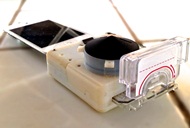 Engineers have taken an ordinary smartphone and made it a whole lot smarter. According to a Los Angeles Times report, they created a compact, handheld device that plugs into an iPhone and turns it into a mobile laboratory that can diagnose HIV and syphilis in just 15 minutes. The diagnostic device – the engineers call it a "dongle" – was tested on 96 patients who were being treated in three community health centers in Kigali, Rwanda. After getting their test results, 97% of the patients said they would recommend it to others.
Engineers have taken an ordinary smartphone and made it a whole lot smarter. According to a Los Angeles Times report, they created a compact, handheld device that plugs into an iPhone and turns it into a mobile laboratory that can diagnose HIV and syphilis in just 15 minutes. The diagnostic device – the engineers call it a "dongle" – was tested on 96 patients who were being treated in three community health centers in Kigali, Rwanda. After getting their test results, 97% of the patients said they would recommend it to others.
Researchers from Columbia University developed the dongle to make it easier for healthcare workers in remote areas to identify people with life-threatening sexually transmitted diseases. The HIV and syphilis tests that are currently available cost as much as $8.50 combined and can take more than 2.5 hours to complete. By then, patients may be long gone.
A rapid, reliable test that can be performed anywhere would be a huge lifesaver in places like Rwanda, the engineers wrote. To make a device that fit this bill, the engineering team had to solve several problems. One of the challenges was to make the dongle simple enough for anyone to use after half an hour of training.
For the version that was tested, patients pricked their fingers to produce 1 microlitre of blood. That tiny sample was then diluted and placed into a cassette that was already loaded with testing agents. After inserting the cassette into the dongle, the user had to squeeze part of the device to get the test going and press "start assay" on an app running on an iPod touch. The app, which would also work on an iPhone, then walked the user through a series of simple steps. After 15 minutes, the blood test results were displayed on the screen.
Another hurdle was to make sure the dongle could operate on very low power. The biggest power savings came from getting rid of a power-hungry electrical pump and replacing it with a squeezable rubber bulb to create a vacuum instead. (The bulb works like the ones on manual blood pressure monitors.)
In the end, the device was so efficient that it was able to run off the iPod's battery power, which was relayed through the headphone jack. The research team was able to run 41 tests before the iPod had to be recharged. (Newer iPhones with longer battery life could probably run even more tests on a single charge, the research team noted.)
[link url="http://www.latimes.com/science/sciencenow/la-sci-sn-smart-phone-dongle-lab-test-20150206-story.html"]Full Los Angeles Times report[/link]
[link url="http://stm.sciencemag.org/content/7/273/273re1"]Science Translational Medicine abstract[/link]
[link url="http://www.nature.com/nature/journal/v444/n1s/full/nature05447.html"]Nature article[/link]
